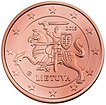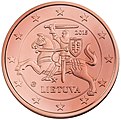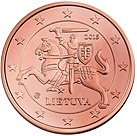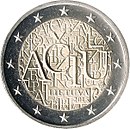Lithuanian euro coins
| The euro coins |
|---|
| Eurozone |
| Associated euro users (with their own euro coins) |
| Passive euro users (without their own euro coins) |
| Possible future euro states |
| Exit clause |
The Lithuanian euro coins are the coins of the common European currency, the euro, put into circulation in Lithuania .
history
Lithuania joined the Exchange Rate Mechanism II on June 28, 2004. Lithuania had unilaterally pegged its litas currency to the euro (EUR 1 = LTL 3.4528).
However, the hoped-for quickest possible introduction of the euro after two years of membership in ERM II on January 1, 2007 failed because of one of the three criteria for membership , inflation : After the litas had continuously shown inflation rates of less than 2% since the ruble crisis in 1999, inflation reached a level due to the booming Economy in the reference period (March 2005 to April 2006) 2.66%. That was only 0.06 percentage points more than the arithmetic mean of the three most inflationary euro member states required in the Maastricht Treaty plus 1.5 percentage points (2.6%).
The Lithuanian Prime Minister Algirdas Butkevičius announced on January 24, 2013 that his country could adopt the euro as early as 2015. "If everything goes according to plan, we are moving towards the euro in Lithuania in 2015," said Butkevičius; he added that his country would actively prepare for the introduction of the common European currency over the next two years.
On June 4, 2014, EU Currency Commissioner Olli Rehn declared that Lithuania now meets the requirements for the introduction of the euro. This is the result of many years of prudent budget policy and economic reforms. Since Lithuania's accession to the EU ten years ago, the country's prosperity has grown “in a remarkable way”. While the per capita gross domestic product (GDP) was 35% of the EU average in 1995, it is expected to reach 78% in 2015. As the EU Commission and the European Central Bank stated in separate reports, Lithuania will be able to introduce the euro on January 1, 2015. According to the report of the EU Commission, Lithuania meets the conditions for accession without any problems: The average inflation rate in the country in the twelve months to April was 0.6%, well below the reference value of 1.7%. The government deficit of 2.1% and the debt level of 39.4% of GDP are well below the EU ceilings.
On June 19, 2014, EU finance ministers approved Lithuania's accession to the euro. On June 27, the heads of state and government of the European Union (EU) gave their approval. On July 16, 2014, the European Parliament, as an advisory body, approved the accession of Lithuania to the euro zone. On July 23, 2014, the EU Council of Foreign Ministers in Brussels gave the go-ahead for the Baltic country to join the common currency union. The ministers also set the exchange rate, which adopted the existing fixed exchange rate of 3.4528 Lithuanian litas to the euro.
On January 1, 2015, Lithuania became the 19th country to join the euro area.
All coins are minted in the Lithuanian mint in Vilnius.
Lithuania's central bank Lietuvos Bankas has already prepared a program for euro commemorative coins (with face values of 5, 20 and 50 euros).
Coin motif
The Lithuanian national coat of arms , which shows the so-called Vytis (“persecutor”), a fighting, armored knight on horseback with a drawn sword, is used as a uniform motif on the euro currency coins . His shield is decorated with a Lorraine cross derived from the Jagiellonian coat of arms . After a design competition, Lietuvos Bankas decided in 2005 to design by Antanas Žukauskas .
| 1 cent | 2 cents | 5 cents |
|---|---|---|

|

|

|
| "Vytis" in the coat of arms of Lithuania | ||
| 10 cents | 20 cents | 50 cents |

|

|

|
| "Vytis" in the coat of arms of Lithuania | ||
| 1 € | 2 euros | Edge of the 2 euro coin |

|

|
|
| "Vytis" in the coat of arms of Lithuania | “LAISVĖ, VIENYBĖ, GEROVĖ” “Freedom, Unity, Welfare” in Lithuanian |
|
2 euro commemorative coins
| No. | image | Issue date image reference |
occasion | Official Journal reference |
Edition |
|---|---|---|---|---|---|
| 1 |  |
17th November 2015 |
30th anniversary of the EU flag Euro-19 joint issue |
750,000 | |
| 2 |  |
December 14, 2015 |
Lithuanian language | 1,000,000 | |
| 3 |  |
May 3, 2016 |
Baltic culture | 1,000,000 | |
| 4th |  |
August 31, 2017 |
Vilnius | 1,000,000 | |
| 5 |  |
January 31, 2018 |
New establishment of the state of Lithuania and establishment of the states of Estonia and Latvia Joint issue of the Baltic states |
1,000,000 | |
| 6th |  |
June 26, 2018 |
Song and dance festival 2018 | 500,000 | |
| 7th | July 10, 2019 |
Sutartinės , polyphonic Lithuanian folk songs | 500,000 | ||
| 8th | September 10, 2019 |
Žemaitija ( Samogitia ) 1st coin in the Ethnographic Regions series |
500,000 | ||
| 9 | 2020 |
Aukštaitija ( Upper Lithuania ) 2nd coin in the Ethnographic Regions series |
500,000 | ||
| 10 | 2020 |
Hill of Crosses | 500,000 | ||
| 11 | 2021 | Žuvintas Biosphere Reserve | 500,000 | ||
| 12 | 2021 |
Dzūkija (Central Lithuania) 3rd coin in the Ethnographic Regions series |
500,000 | ||
| 13 | 2022 | 35 years of the Erasmus program Euro 19 joint edition |
Collector coins
5 euros
| theme | Issue date | material | Dimensions | diameter | Edition |
|---|---|---|---|---|---|
| 25 years of restoration of independence | 2015 | Copper / nickel | ? | 28 mm | 25,000 |
| literature | 2015 | silver | 11.51 g | 12.44 mm | 4,000 |
20 Euros
| theme | Issue date | material | Dimensions | diameter | Edition |
|---|---|---|---|---|---|
| 25 years of restoration of independence | 2015 | silver | 28.28 g | 38.61 mm | 4,000 |
| 500th birthday of Mikalojus Radvila Juodasis | 2015 | silver | 28.28 g | 38.61 mm | 3,000 |
| Struve arch | 2015 | silver | 28.28 g | 38.61 mm | 3,000 |
50 Euros
| theme | Issue date | material | Dimensions | diameter | Edition |
|---|---|---|---|---|---|
| Coinage | 2015 | gold | 7.78 g | 22.3 mm | 5,000 |
Web links
- European Central Bank
- Side of the Bank of Lithuania (English)
- Information on the introduction of the euro and the Lithuanian euro coins
Individual evidence
- ↑ Euro entitlement 2004–2010 , accessed on March 2, 2013.
- ↑ [1] (PDF; 933 KiB)
- ↑ EU Commission recommends Lithuania's accession to the euro. Accessed on June 4, 2014
- ↑ EU finance ministers approve Lithuania's entry into the euro. Accessed June 21, 2014
- ↑ EU heads of state and government for Lithuania to join the euro.Retrieved on June 27, 2014
- ↑ DIE WELT: European Parliament approves Lithuania's accession to the euro zone. Accessed on July 17, 2014
- ↑ ECB: Lithuania joins euro area and single supervisory mechanism on January 1, 2015.Retrieved July 24, 2014
- ↑ DW: Lithuania's accession to the euro sealed ( memento of July 24, 2014 in the Internet Archive )
- ↑ FAQ Bundesbank , accessed on October 20, 2015.
- ↑ Lietuvos Bankas: Lithuanian Collector Coin Program 2015 ( Memento of the original from March 4, 2016 in the Internet Archive ) Info: The archive link has been inserted automatically and has not yet been checked. Please check the original and archive link according to the instructions and then remove this notice. , Retrieved January 11, 2014.
- ^ Museum of the National Bank of Belgium: History and Coat of Arms of Lithuania , accessed on January 2, 2015
- ^ Lithuanian postage stamps 2015 with Vytis images of historical coins , accessed on February 28, 2015
- ↑ Münzscan Lithuania 2015: EU flag , accessed on November 18, 2019
- ↑ Official Journal of the European Union: New national side of the euro coins in circulation (2015 / C 257/07, August 6, 2015) , accessed on August 6, 2015
- ↑ Lithuania 2015: 30 Years of the European Flag , accessed on November 4, 2015
- ↑ Münzscan Lithuania 2015: Lithuanian language , accessed on January 30, 2016
- ↑ Official Journal of the European Union: New national side of the euro coins in circulation (2015 / C 357/03, October 29, 2015) , accessed on December 16, 2015
- ↑ Commemorative Lithuania coin 2015: Language of Lithuania , accessed on November 18, 2019
- ↑ Münzscan Lithuania 2016: Baltic Culture , accessed on August 4, 2016
- ↑ Official Journal of the European Union: New national side of the euro coins in circulation (2016 / C 103/02, March 18, 2016) , accessed on May 9, 2016
- ^ Commemorative coin Lithuania 2016: Baltic Culture , accessed on May 9, 2016
- ↑ Münzscan Lithuania 2017: Vilnius , accessed on December 5, 2017
- ↑ Official Journal of the European Union: New national side of the euro coins in circulation (2017 / C 329/09, September 30, 2017) , accessed on September 30, 2017
- ↑ Commemorative coin Lithuania 2017: Vilnius - City of Culture and Art , accessed on September 1, 2017
- ↑ Münzscan Lithuania 2018: Independence , accessed on November 18, 2019
- ↑ Official Journal of the European Union: New national side of the euro coins in circulation (2018 / C 21/02, January 20, 2018) , accessed on January 31, 2018
- ↑ Commemorative coin 2018: 100 years of independence , accessed on January 31, 2017
- ↑ Münzscan Lithuania 2018: Song Festival , accessed on December 13, 2018.
- ↑ Official Journal of the European Union: New national side of the euro coins in circulation (2018 / C 119/05, April 5, 2018) , accessed on June 26, 2018
- ^ Commemorative coin Lithuania 2018: Song and Dance Festival 2018 , accessed on June 26, 2018
- ↑ Münzscan Lithuania 2019: Sutartinės , accessed on August 13, 2019
- ↑ Official Journal of the European Union: New national side of the euro coins in circulation (2019 / C 351/11, October 17, 2019) , accessed on October 23, 2019
- ↑ Lithuania commemorative coin 2019: Lithuanian Folk Songs - Sutartinės , accessed on July 11, 2019
- ↑ Münzscan Lithuania 2019: Žemaitija , accessed on December 20, 2019
- ↑ Official Journal of the European Union: New national side of the euro coins in circulation (2019 / C 351/10, October 17, 2019) , accessed on October 23, 2019
- ↑ Commemorative coin Lithuania 2019: Lithuanian Ethnographic Regions - Žemaitija , accessed on September 10, 2019
- ^ Coin image Lithuania 2020: Aukštaitija (Upper Lithuania) , accessed on December 26, 2019
- ↑ Official Journal of the European Union: New national side of the euro coins in circulation (2020 / C 53/04) , accessed on February 17, 2020
- ↑ Lithuania commemorative coin 2020: Lithuanian Ethnographic Regions - Aukštaitija , accessed on November 18, 2019
- ↑ Coin image Lithuania 2020: Hill of Crosses , accessed on February 18, 2020
- ↑ Lithuania commemorative coin 2020: Hill of Crosses , accessed on November 18, 2019